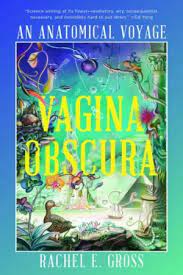Vagina Obscura: An Anatomical Voyage
Vagina Obscura: An Anatomical Voyage, by Rachel E. Gross (2022) is a remarkable combination of information about anatomy, health, history, science, biography, and sociology related to the female organs. It is also my choice for the topic of Health for the Nonfiction Reader Challenge.
The
book organizes these organs into separate chapters according to their
presenting characteristic:
- Desire (Glans Clitoris)
- Wholeness (Internal Clitoris)
- Resilience (Vagina)
- Protection (Vaginal Microbiome)
- Creation (Egg Cell)
- Power (Ovaries)
- Regeneration (Uterus)
- Beauty (Neovagina)
Each
chapter focuses on the particular body part using the stories of medical
personnel, specific women, and historical figures to give background and information
about the organ’s function, development and physical description. Although the
narrative often includes detailed biological and technical data, Gross makes it
as interesting as a novel. I found myself unable to put the book down at times,
wanting to know more about the continuing “story.”
A
recurring theme throughout the book is how little is known about these organs,
because medicine and science have never focused on them. Male doctors and psychiatrists
have written about the vagina, uterus and ovaries throughout history without
actually studying them. And clinical trials have used only male bodies to
determine basic information about the function and health of the human body.
This reminded me of the chapter on health in the book Invisible Women: Exposing Data Bias in a World Designed for Men (see my post of April 4, 2022). Gross
writes that it wasn’t until 1991 that the U.S. required women and minorities to
be included in clinical trials. And it was as recently as 2014 (!!!) that the
National Institutes of Health started studying women’s bodies (e.g., vaginas,
vulvas, uteruses, ovaries). And the research that has been done on women’s
bodies has focused only on their function in child-bearing.
Not only have women’s bodies been ignored by
science, but also women involved in scientific projects as well. One of the examples
Gross writes about is Miriam Menkin. I had never heard of her, but she was the
first person to fertilize a human egg in the laboratory (outside the body).
This enabled the development of IVF treatments as well as the understanding of how
the egg and embryo develop, but she is not mentioned in most information about
these areas (the men she worked with are, however).
I was surprised by how much I didn’t know about my
own female body. Textbooks tell us that a female is born with all the eggs she
will have in her life, but recent research has proven that isn’t true. It turns
out that ovaries have stem cells that allow the ovaries to make new eggs until
menopause. This research was disbelieved at first by many in the medical field.
But Gross, referring to Jon Tilly, the reproductive scientist who discovered
this, writes “He compares the idea of ovaries making new eggs to the idea that
the brain generates new neurons—a finding the field of neuroscience considered
ludicrous before the 1990s but is now accepted as scientific fact.”
I also had never known that the clitoris is not
just an external organ, but has a large internal section as well. Gross reports
the information she learned from Dr. Helen O’Connell, an Australian urologist
who has studied the clitoris (one of the few people to ever do so) and whose
doctoral thesis is “perhaps the most thorough exploration of the anatomy and
history of the human clitoris ever written”.
O’Connell became interested in this organ during
her medical studies, when she realized how much information was devoted to
studying the penis, while almost nothing was written about the clitoris. In
referring to her medical textbooks, she said, “The clitoris barely got a cameo;
a cross-section of the female pelvis omitted it entirely. Meanwhile, four pages
were devoted to the penis.”
The Afterword consists
of information from conversations and emails Gross had with Bo Laurent, “the
most well-known intersex activist in the world.” Gross reports that Laurent
encouraged her to “investigate another consequence of our anatomical ignorance
about this part of the body: a form of genital cutting still being practiced
right here in the United States, on children born with ‘unusual sex anatomy.’”
Gross has interviewed many people in the medical
field, as well as women who have been ignored, disbelieved, and misdiagnosed when
their medical problem was related to their genital organs. She was given “unparalleled
access to labs and the latest research.” And she has put it all together in an
extremely interesting, readable, amazing narrative.
At the beginning of the book, she tells the reader:
“This
book was written for any woman—any person—who has found themselves mystified by
their own body. Anyone who has felt the nagging suspicion that what they have
read about their anatomy wasn’t written for them, or by someone like them. You were
right. This book was written for you. It was written for anyone who has felt
unable to talk about their body in language that others could understand. Anyone
who wants to better understand the legacy they were born with, by virtue of
their reproductive organs and the chromosomes dancing within their every cell.”
This book has certainly helped me better understand
the legacy I was born with and has enabled me to realize just how magnificent the
female body is.


Comments
Post a Comment